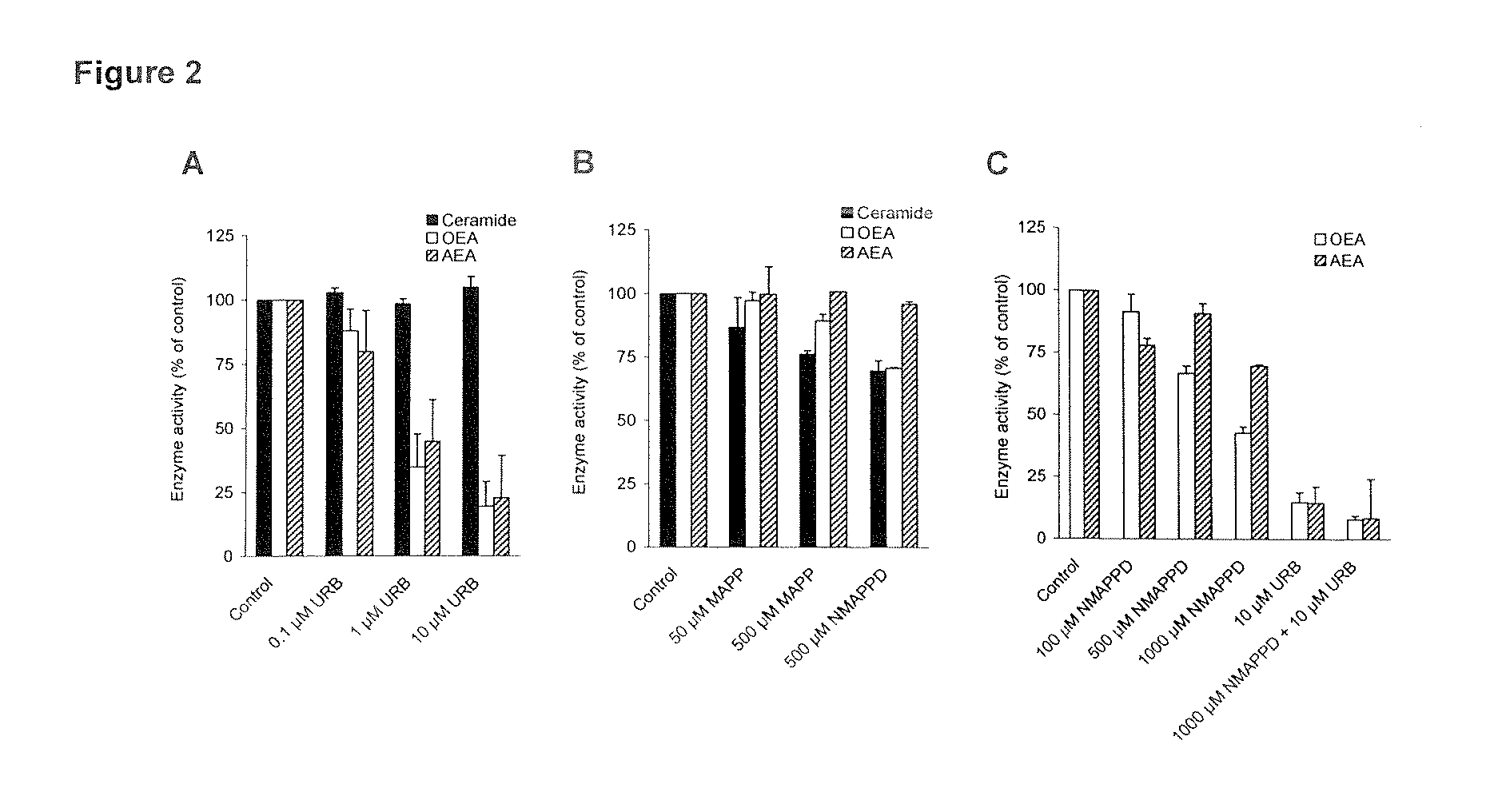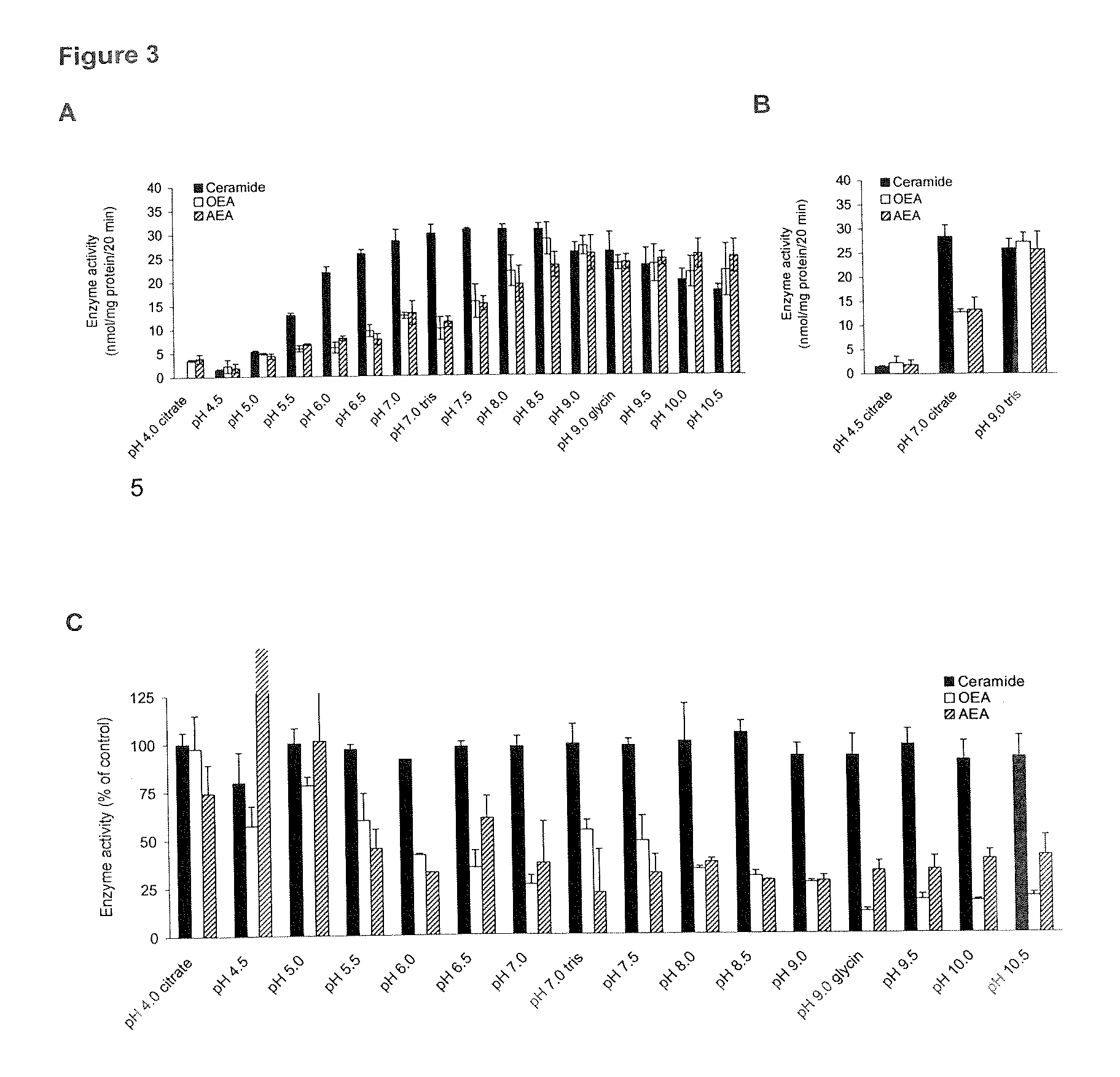Inhibitors of anorexic lipid hydrolysis for the treatment of eating disorders
- Summary
- Abstract
- Description
- Claims
- Application Information
AI Technical Summary
Benefits of technology
Problems solved by technology
Method used
Image
Examples
example 1
Effects of D-erythro-MAPP, D-threo-NMAPPD, and URB597 on A) OEA and Anandamide Hydrolysis and B) Ceramide Hydrolysis by Intestinal Protein from (URB597 Treated) Rats
[0098]The aim of the in vitro studies (examples 1-2) is to prove that part of OEA hydrolysis in intestinal tissue is due to an enzyme different from FAAH, which is characterized as an acylethanolamide / acylamide hydrolyzing enzyme with approximately 5-fold preference for anandamide (AEA) compared to OEA (21).
[0099]1A: OEA hydrolysis is determined in an assay modified from Fegley et al. (14) with 50 μg of intestinal protein from male Sprague-Dawley rats (approximately 200 g), URB597 (Cayman Chemical, Ann Arbor, Mich., USA) treated (0.3 mg / kg i.p. 1 h prior to anaesthesia) and untreated [4 ml / kg of vehicle (saline / Tween 80 / polyethylene glycol; 90:5:5) i.p. 1 h prior to anaesthesia], incubated with 28 μM of [1−3H-ethanolamine]OEA (from American Radiolabeled Chemicals, Inc., St. Louis, Mo., USA diluted with non-labeled OEA fr...
example 2
ph Dependency of A) OEA Hydrolysis, B) Ceramide Hydrolysis, and C) Anandamide Hydrolysis by Intestinal Protein from (URB597 Treated) Rats
[0102]2A: The pH-dependency of OEA hydrolysis without D-erythro-MAPP is assayed using similar conditions as described in example 1A with 50 μg intestinal protein from Sprague Dawley rats (approximately 200 g), URB597 treated (0.3 mg / kg i.p. 1 h prior to anaesthesia) and untreated [4 ml / kg of vehicle (saline / Tween 80 / polyethylene glycol; 90:5:5) i.p. 1 h prior to anaesthesia], incubated with 28 μM [1−3H-ethanolamine]OEA (10 dpm / pmol) for 0, 10, 20, and 30 min at 37° C. in a total volume of 200 μl of varying buffers containing 0.9 mM EDTA, 1.5 mg / ml fatty acid-free bovine serum albumin. Alternatively, 25 μg of protein from rat intestinal (jejunum) homogenate in a total volume of 100 μl and 50 μM of 3H-oleoylethanolamide (OEA; 25.000 dpm) was used with or without 10 μM of URB597 (200 μM added in 5 μl of DMSO) and incubated for 0 and 20 min at 37° C. A...
example 3
Inhibition of Food Intake in Mice / Rats Following MAPP / NMAPPD Administration
[0107]In order to evaluate the effect of a ceramidase inhibitor on food intake—possibly via prolongation of the effect of endogenously produced OEA the following in vivo experiments were designed. Furthermore, co-administration of a sub-maximal dose of OEA along with a ceramidase inhibitor was planned to substantiate the possible mode of action of the compounds of the invention.
[0108]3A: Inhibition of food intake in rats following administration of an inhibitor of ceramidase. Thirty male Sprague Dawley rats (6 weeks of age, approximately 190 g, Charles River, Germany) are used following the acclimatization protocol described above. The rats are randomized into weight-matched groups of n=6 then fasted for 24 h with removal of food just before beginning of the dark period. The next day they receive an acute dose of 0.05; 0.2; 0.5; 2; or 5 mg / kg of D-erythro-MAPP or vehicle (saline containing 2.8% ethanol) admin...
PUM
| Property | Measurement | Unit |
|---|---|---|
| Electrical conductance | aaaaa | aaaaa |
| Dimensionless property | aaaaa | aaaaa |
| Dimensionless property | aaaaa | aaaaa |
Abstract
Description
Claims
Application Information
 Login to View More
Login to View More - R&D
- Intellectual Property
- Life Sciences
- Materials
- Tech Scout
- Unparalleled Data Quality
- Higher Quality Content
- 60% Fewer Hallucinations
Browse by: Latest US Patents, China's latest patents, Technical Efficacy Thesaurus, Application Domain, Technology Topic, Popular Technical Reports.
© 2025 PatSnap. All rights reserved.Legal|Privacy policy|Modern Slavery Act Transparency Statement|Sitemap|About US| Contact US: help@patsnap.com



